This easy-to-read guide will show you how to see the Financial District in New York City in under 60 minutes. It is the same route I used when I gave tours years ago.
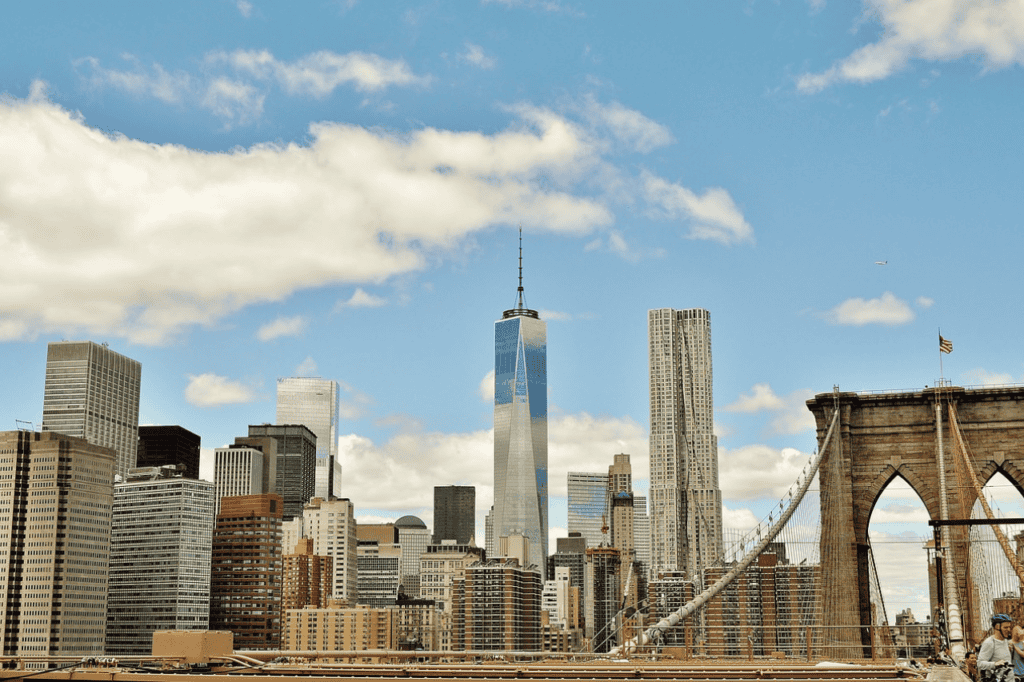
The route will take you to landmarks such as Wall Street, Trinity Church, the first restaurant in the United States, and the oldest building in New York City, just to name a few. It will include some brief history and some anecdotes to keep you interested.
There are many names to describe the area: Downtown Manhattan, Wall Street, Financial District, FiDi. But one thing is for sure, the Financial District is the birthplace of New York City. It is where the immigrants all started to arrive in the 1600’s, and where the financial backbone of the United States began.
If you do not have enough time in your schedule to go on a guided walking tour of the area, this guide will help you make the most of your day. So grab your water bottle and camera and let’s hit the pavement!
Follow the BOLD SENTENCES for walking directions and use the images to locate the landmark.
#1. Start at St. Paul’s Chapel, between Fulton Street and Vesey Street, 209 Broadway
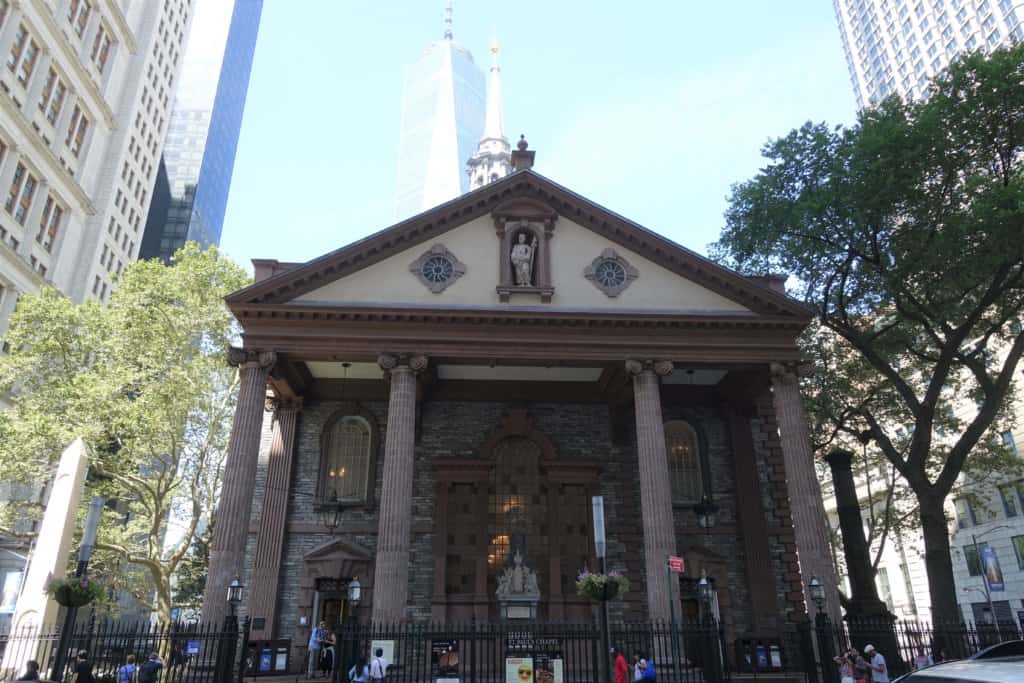
- Built in 1776 and nicknamed “The Little Chapel that stood”, it is the oldest surviving church in Manhattan.
- There is no fee to enter the church and connecting graveyard.
- The pew that the first American President, George Washington used, is on display inside the church.
- In 1776 there was a Great Fire that destroyed the majority of downtown Manhattan, but the church was not harmed.
- In 1886, there was a bridge that stretched across the busy street in front of the church, from Fulton to Broadway. However, there was an angry hat salesman who was not happy about the shadow that was cast in front of his store because of the location of the bridge, and he and other business owners fought the city for it to be taken down. The mad hatter and his colleagues fought to have the bridge taken down in less than a year.
#2: Walk West on Fulton Street towards the World Center Path Station (WTC Hub)
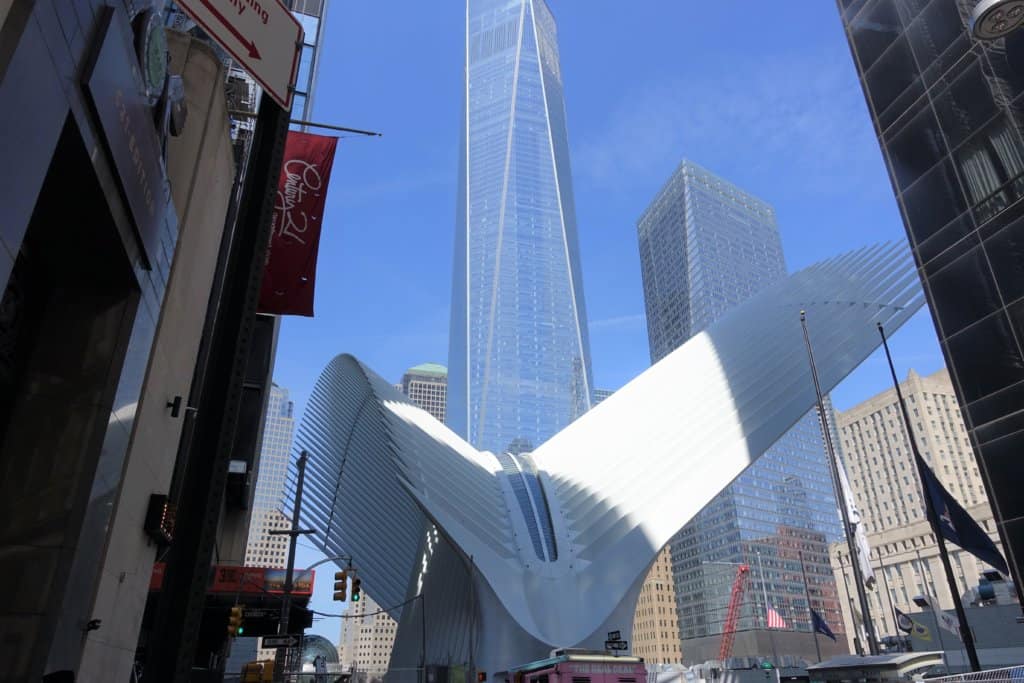
- Completed and opened in 2016, it serves as a mall and transportation hub to New Jersey.
- It cost $3.74 billion to build and New Yorkers find the architecture distasteful. The locals have nicknamed it the “White Elephant”, the “Monstrosity”, and the “Giant White Space Insect”.
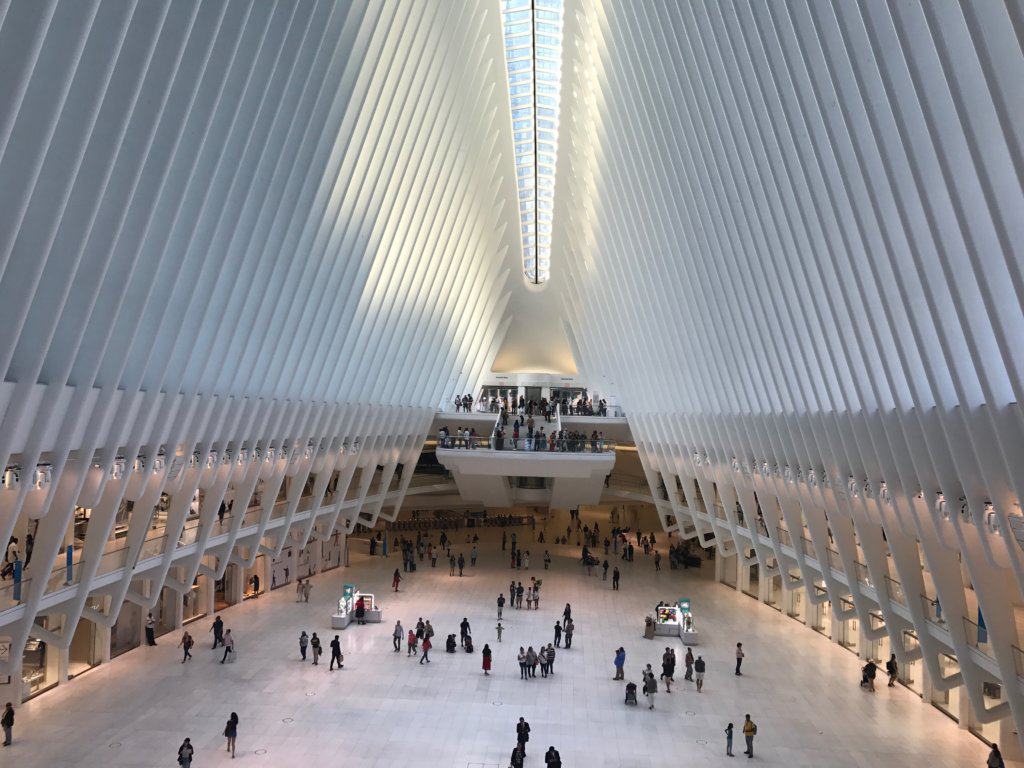
- Look up at the ceiling and you will see that the ceiling has a skylight. The original design called for the ceiling to open at certain times of the day. It was supposed to symbolize two hands clasped together and when the fingers separate and open, it would create the illusion that a bird was being released from two hands. Security shut that idea down, saying that the hub could not have a ceiling that opened and closed, and it needed to be able to support anything that may have the potential of falling inside of the hub (like a crane or another building).
- The station is a perfect place to stop if you need to use a restroom, or possibly get some air con relief or warm up in the winter months.
#3. While inside, look for signs at the 911 Memorial/Museum. This will lead you to the 911 Memorial which is located next to the WTC station.
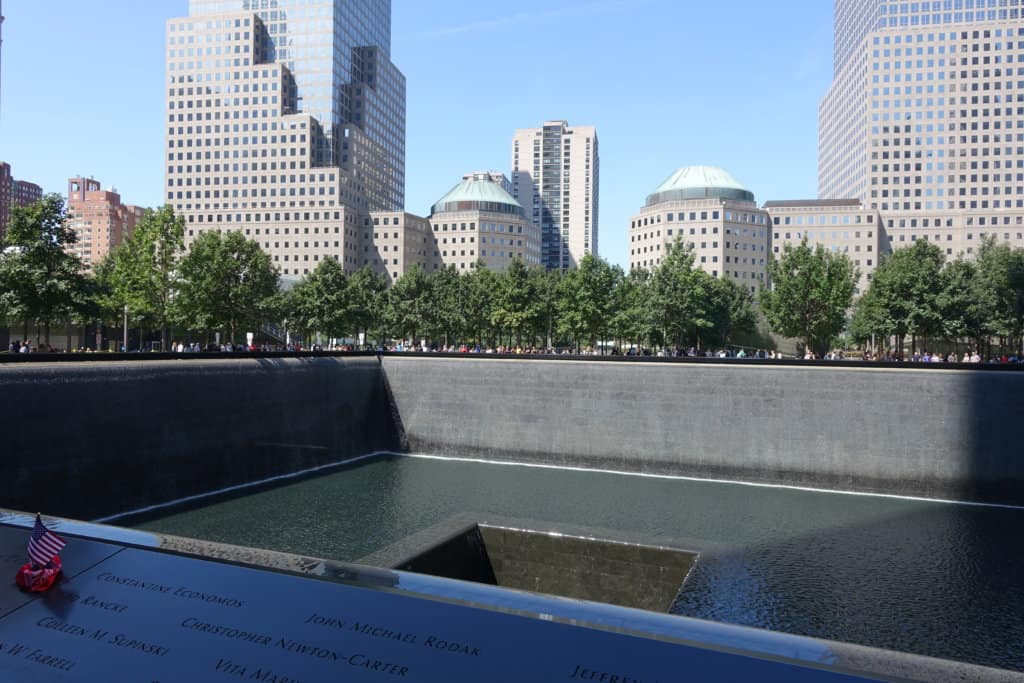
- This is the location of where the two twin towers used to stand and all the names of the people who lost their lives during the 911 attacks are on display.
- You will see a lot of tourists taking selfies smiling and putting their purses on the ledge where the fallen victims’ names are inscribed. Please do not follow suit. Be respectful as this is a place of mourning.
- The 911 museum is located next to the memorial if you have longer than an hour to visit the Financial District.
- From here you can see One World Trade Center. It is the tallest building in North America and the 6th tallest in the world. You must buy a $34 timed ticket to ride the elevator up the 104 stories to the observation deck. Visiting the tower is not part of the one-hour walking tour.
#4. Walk East towards Broadway and cross over Greenwich and Church Street. Take a right on Broadway and a left on Wall Street. You will see Federal Hall on your left once you walk a few feet down Wall Street.
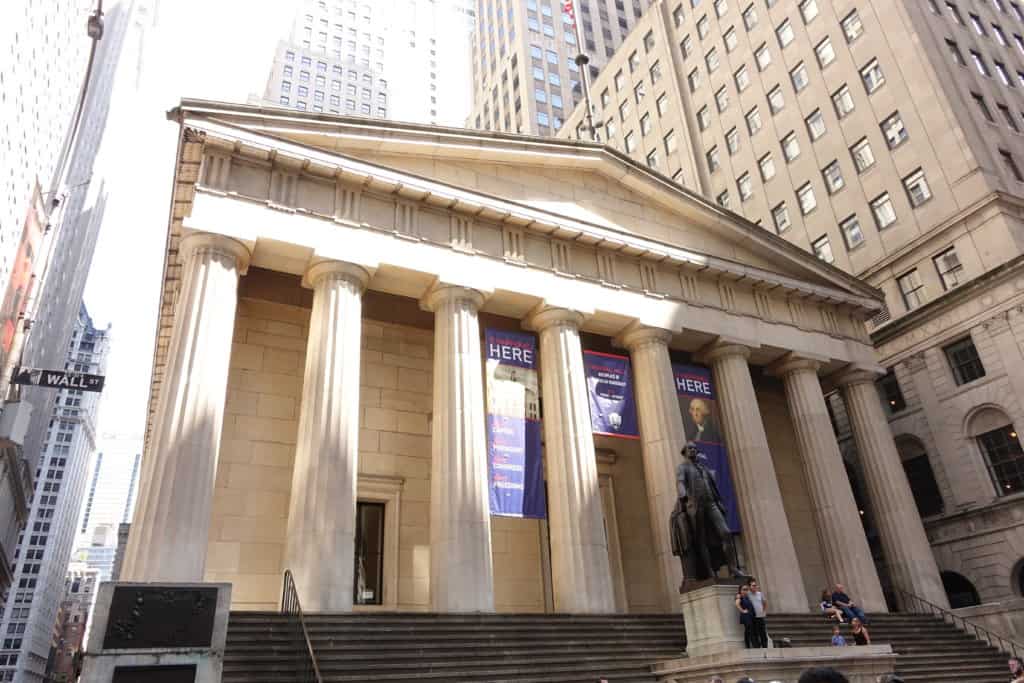
- This is the site of the original Federal Hall Building which was built in 1703. It is where George Washington was sworn in as the First President of the United States, and the Bill of Rights was also written and signed here.
- It was the first capital building of the United States before the capital was moved to Philadelphia and then D.C..
- The original building has since burned down, and the building you are looking at was erected in 1842 and used as a customs house. A customs house in the 1800s was used for exporters and importers to pay their taxes, and the money they paid was stored in this building.
- Currently, it is a free museum, and inside they have the original bible that George Washington was sworn in.
#5. With the Federal Building on your left, walk towards the East River down Wall Street.
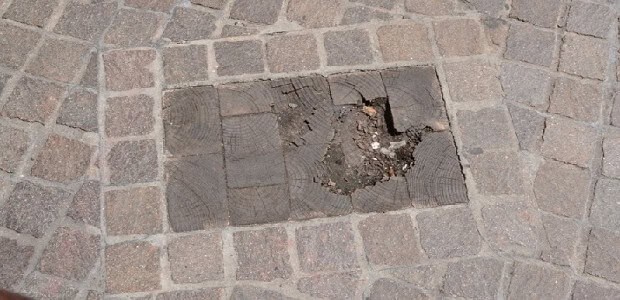
- Looking down at the cobblestone, you will see wooden boards in a square shape.
- These squares indicate where an actual 1300-foot wooden wall was erected in the 1600s by Peter Stuyvesant. Peter was the man the Dutch sent over to whip the original settlers who weren’t doing much but drinking, into shape. He built this wall to keep out the Native Americans and stop the British from taking the island of Manhattan from the Dutch.
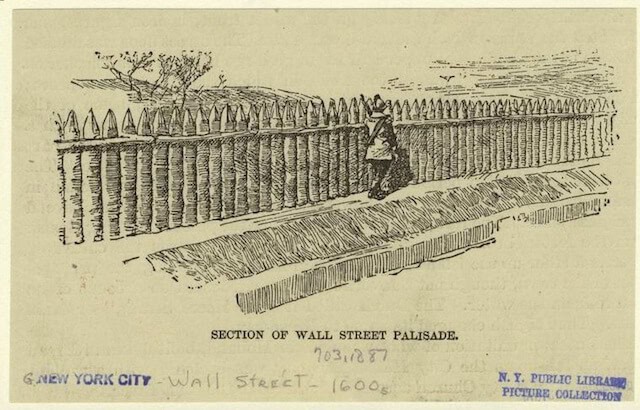
- Peter was unaware that the British had the largest naval fleet in the world. The wall did not stop the British from attempting to take the land from us, as they arrived by boat and docked at the tip of Manhattan, south of the wall, in 1665.
- Not many people liked Peter so the settlers agreed that the British could have control of the land, and the British immediately took the wall down and ruled Manhattan for a total of 119 years.
#6. Continue walking East toward the river and stop once you see some damage on the side of 23 Wall Street.
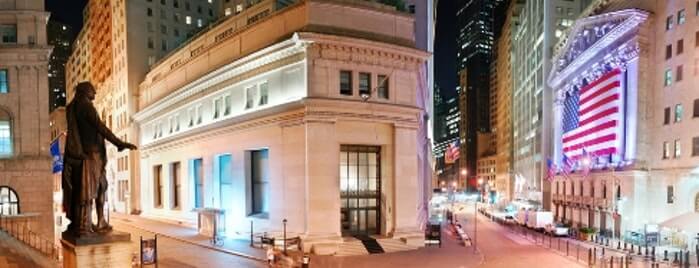
- Known as the “House of Morgan” and built-in 1913, this building was the first J.P. Morgan Bank. J.P. Morgan was one of the most profitable bankers of his time and built his bank smack into the middle of the Financial District. The bank has since moved uptown and now 23 Wall Street is used for private parties.
- You will notice the building is shorter than others. He did this on purpose to show the other millionaires in the area that he did not need a high-rise building with space to rent above his bank, as he was rich enough and didn’t need the extra income.
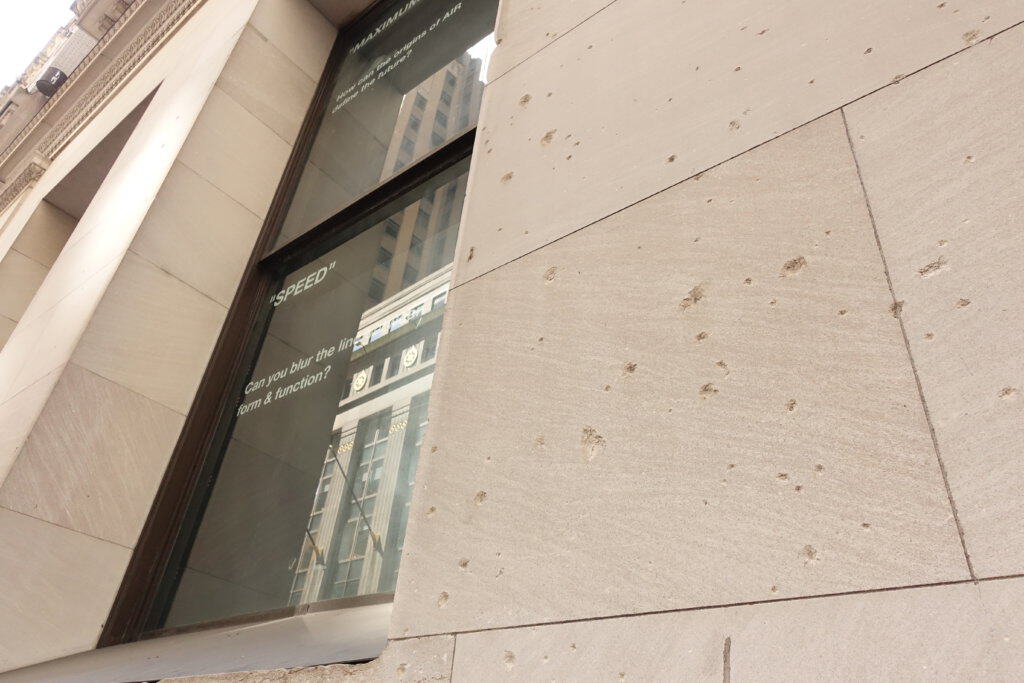
- The marks on the side of the building indicate where the first terrorist attack on United States soil took place. In 1920, a horse and carriage filled with dynamite was ignited and exploded at lunchtime. Hundreds were injured and 38 people died.
- Most New Yorkers assumed the attack was an attempt to take down Wall Street and our financial backbone. However, historians believe that the attack was pulled off by Italian anarchists in revenge for some of their fellow Italians being wrongfully arrested and indicted for crimes not related to Wall Street. Morgan’s predecessors kept the marks on the outside of the building to keep it as a reminder that we are stronger than any terrorist attack.
#7. Walk West a few feet towards the New York Stock Exchange Building
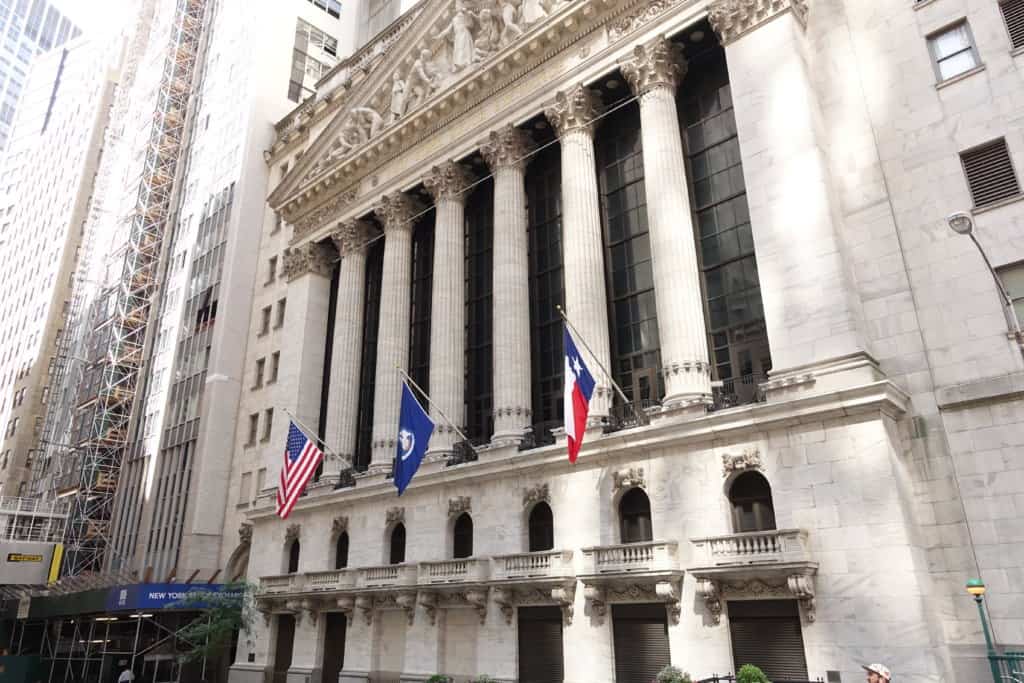
- This building was erected in 1903, but the New York Stock Exchange started long before that in 1792, under a buttonwood tree. Auctioneers and stockbrokers got together and formed a committee that set a commission of 25% for all stock sales. Eventually, they didn’t want to sit under the tree anymore and moved to the Tontine Coffeehouse which is no longer standing, and then to this building in 1903.
- The NYSE has 1366 seats but don’t get too excited about the prospect of getting one of them. The seats cost anywhere from $1- $4 million each.
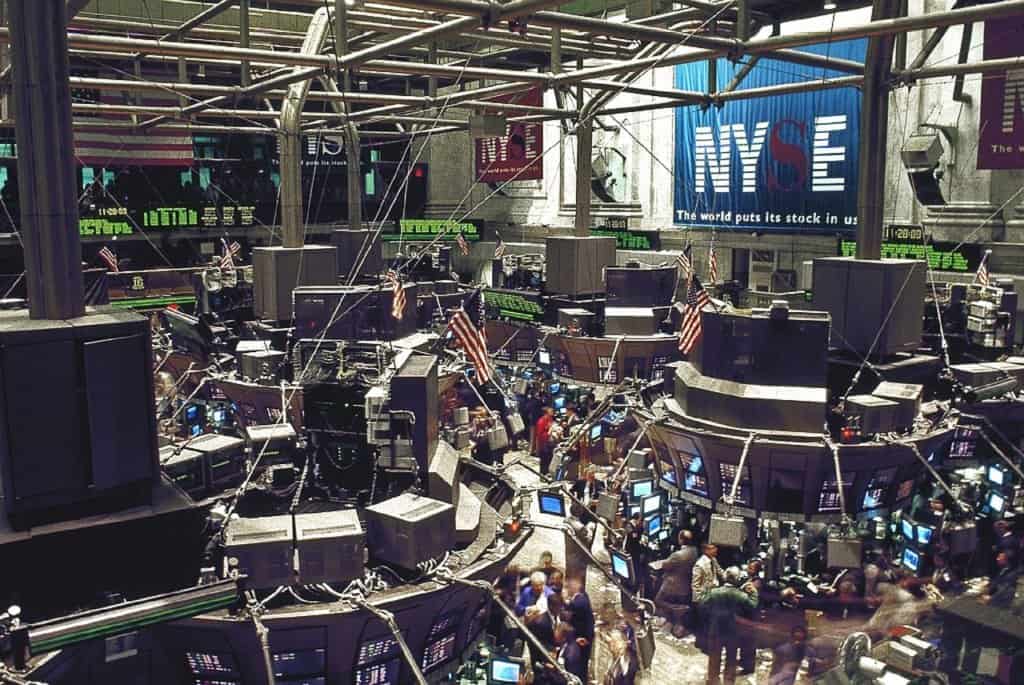
NYSE in the Financial District
- People always picture the inside of the NYSE being full of stockbrokers running around in suits holding pieces of paper high in the air yelling and shouting numbers. To our disappointment, most of the stock exchange is automated by computers now, but there are still a handful of humans left on the floor running around.
- The small piece of paper that they used to print the stock prices on, is called ticker tape. It got this name due to the noise the machine made when the paper was printing: “tick tick tick.” The full names of companies used to be printed on small paper until someone came up with the idea to shorten the names to letters to make the paper print faster. For example, J.P. Morgan Bank is now JPM.
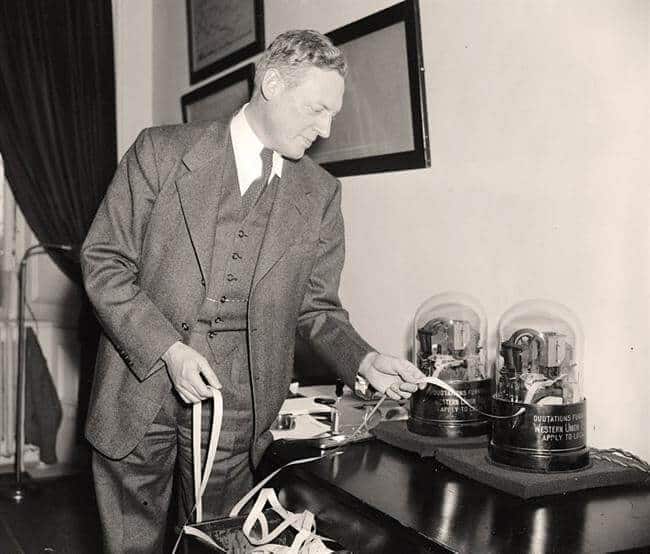
- If you have ever wondered how stockbrokers used to communicate the current stock prices to other cities such as Boston and Philadelphia before the world of telephones and computers, we can tell you. Men used to stand on the rooftops of the NYSE and other buildings and hold a telescope and a piece of paper. When a stock price was set, the men would write the stock price on the piece of paper and hold it in front of the telescope so that the next man on the roof of the next building could see the number. He would in turn write the number down and show it to the next person until it reached the final destination. It would take about an hour to send numbers to Boston this way in the 1800’s.
#8. Head South on Broad Street (away from the Federal Building) and make a left on Beaver Street
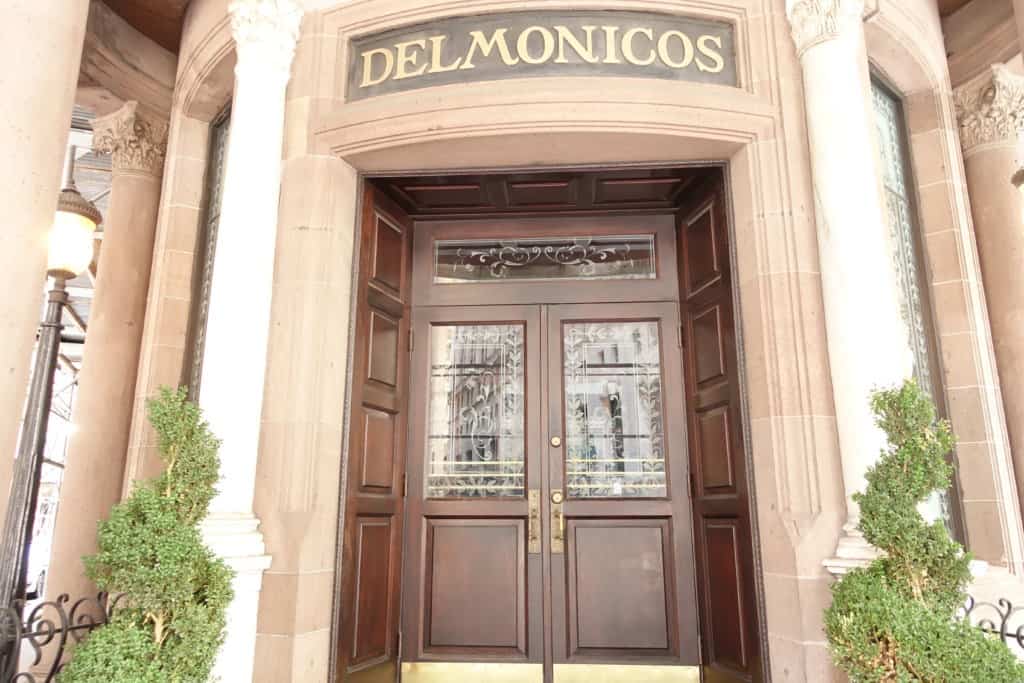
- The round building on the corner of Beaver and South William Street is the first restaurant in the United States. It was opened by two brothers from Switzerland who arrived in the Financial District in 1827.
- Before this restaurant opened, the only place to get food was at taverns or oyster bars. The chef would make one dish and that same dish was served all day.
- Delmonico’s introduced a menu where you could make choices provided linen on the tables and was the first establishment to allow a woman to dine alone. Before that a woman had to be accompanied by a man or she would be considered a call girl.
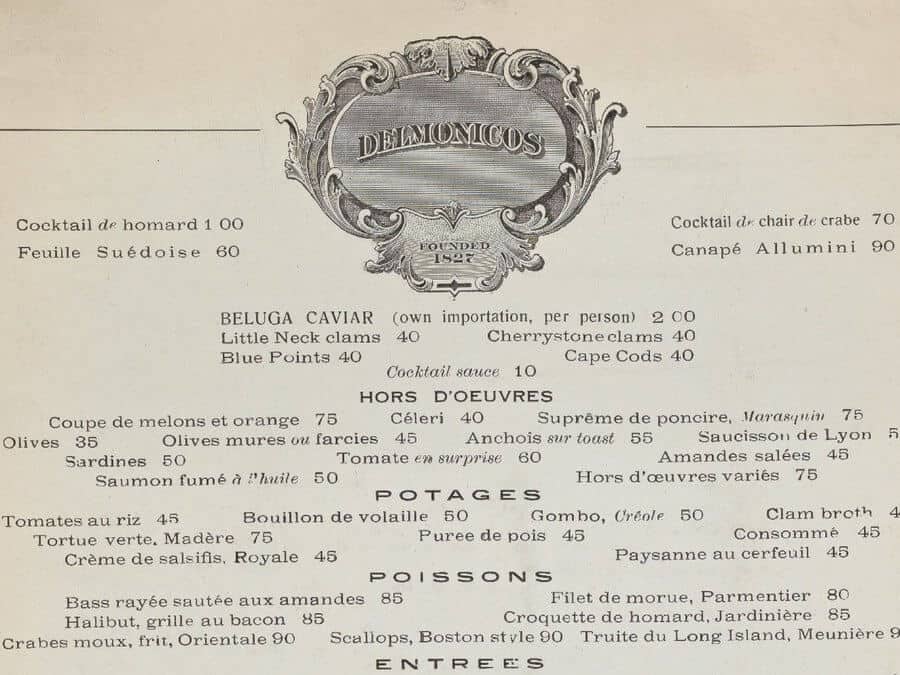
- Some of the dishes they lay claim to are: Lobster Newburgh, Eggs Benedict, and Baked Alaska.
- The menu was huge: 32 appetizers, 46 veal entrees, 20 mutton entrees, 47 poultry entrees, and 40 desserts!
- Famous clientele include Alexander Hamilton, Napoleon and Abraham Lincoln.
- The restaurant still serves some of the original dishes, but it can be expensive.
#9. Walk down William street towards the East River and make a right on Stone street.
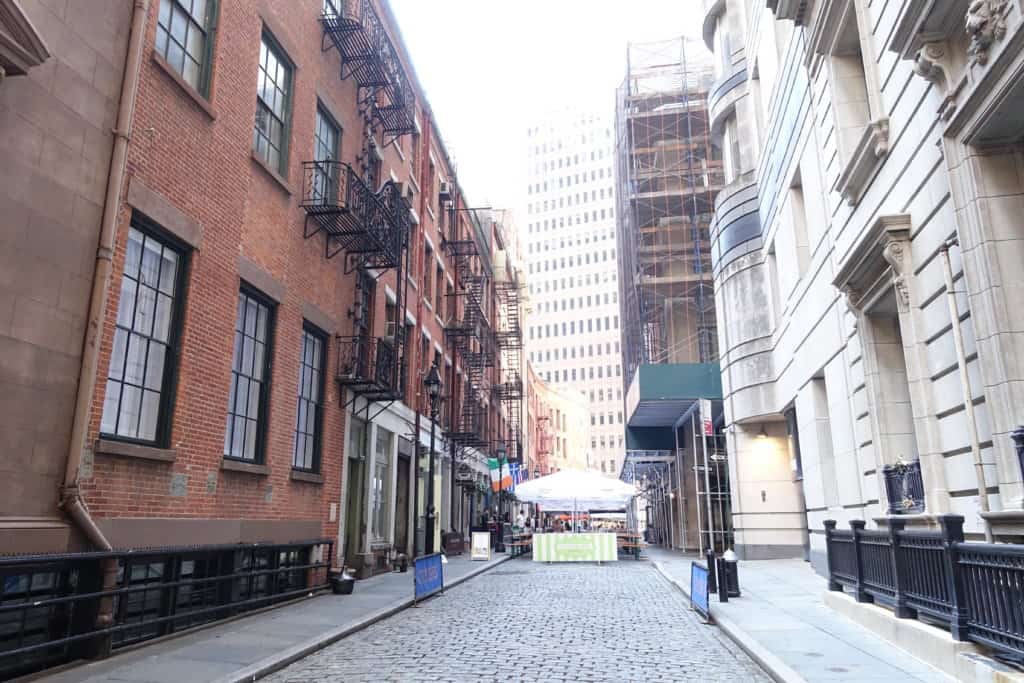
- Stop walking before you get to the tents and look down at the ground. This street is considered the first paved road in the United States.
- The stones were laid down in the 1700’s to stop the runoff from the multiple breweries that used to be open on this street. People walked to the East River (which was a lot closer to Stone Street than it is today), picked up stones and laid them down to stop the mud from flowing.
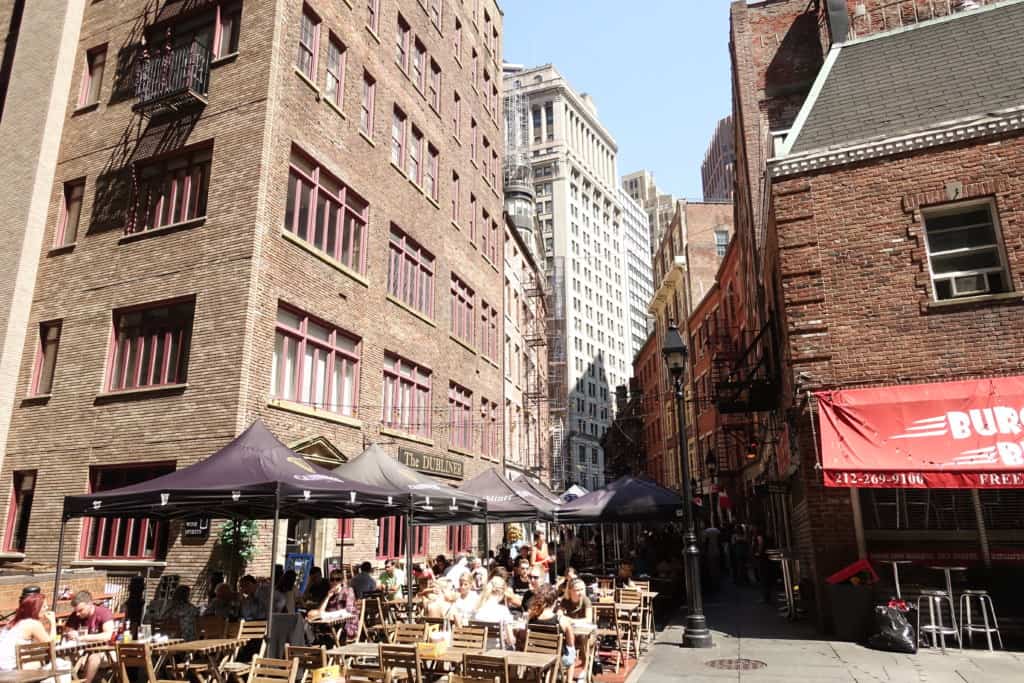
- If it’s lunch or dinner time, Stone Street gives you many options of places to eat. One of our favorites is the German restaurant called Bavaria Bierhouse.
#10. Walk through the tents to the end of Stone Street, make a left through the courtyard and a right on Pearl Street. At the end of Pearl Street is Fraunces Tavern.
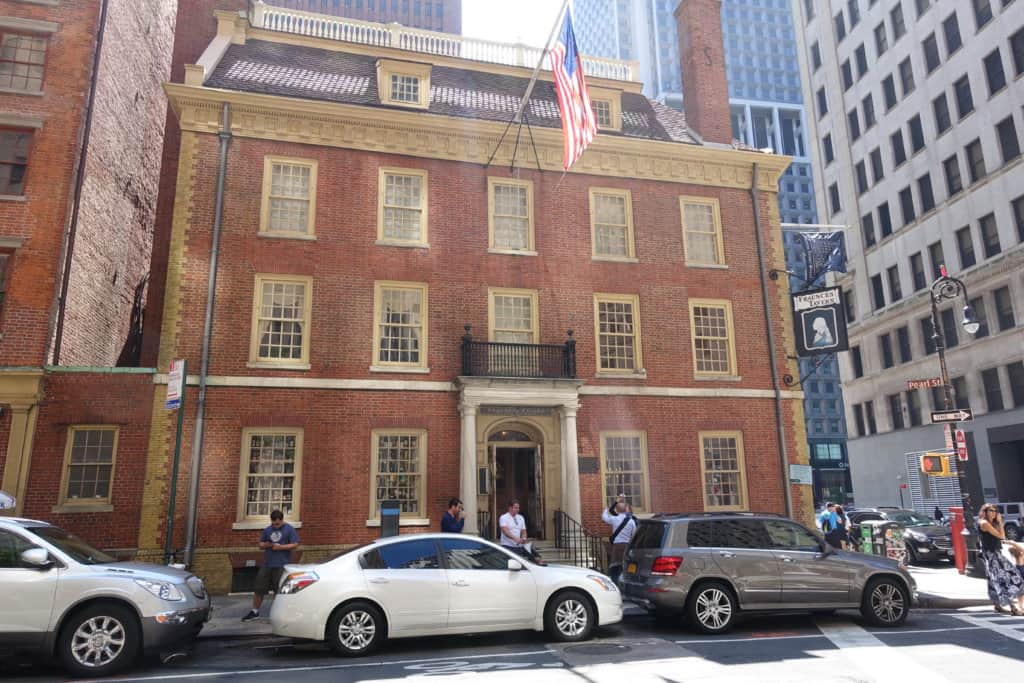
- Built in 1719, this restaurant, bar, and museum is the oldest surviving building in NYC. It survived the great fire of 1776 and also when a cannonball landed in the ceiling of the main hall during the Revolutionary War.
- Between 1775 and 1783 it was used as the headquarters for George Washington and the British to make negotiations during the war.
- It was first a house, then a tavern, then a hotel and now back to a tavern.
- The original owner, Samuel Fraunces, was revered by George Washington so much, that the President himself asked the owner to be his personal chef at Mount Vernon in Virginia.
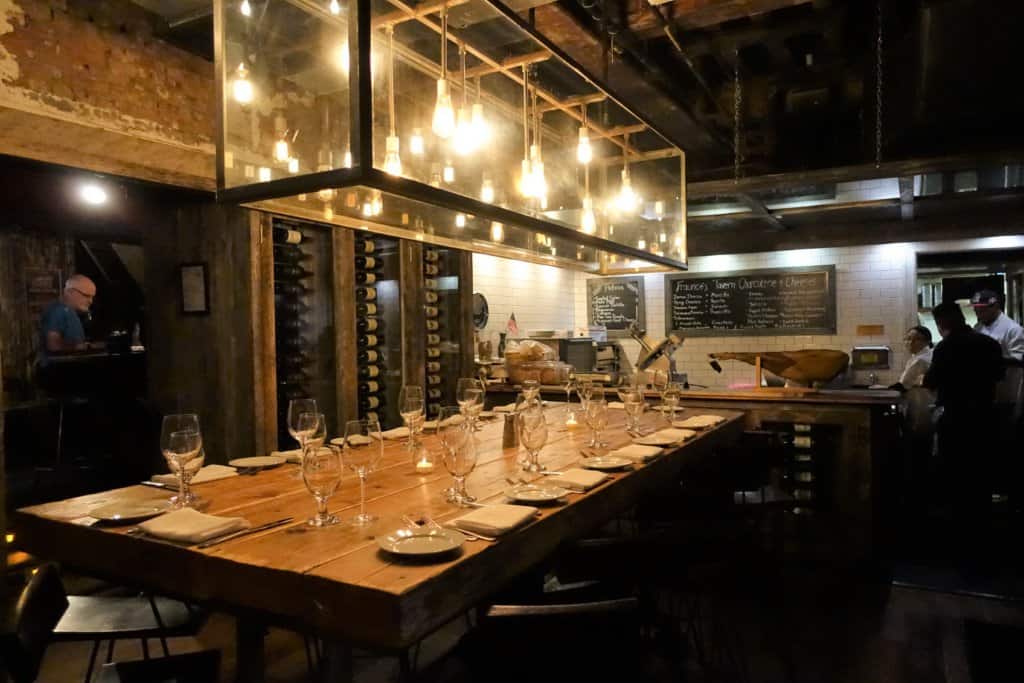
- After America won independence from British rule in 1783, George Washington held the farewell dinner for his troops at Fraunces Tavern. At the dinner, they drank 133 bottles of wine and George Washington himself was seen crying. Legend has it that he was crying not because the war was over, but because he knew that the government had no money to pay the soldiers he was saying farewell too, for all their efforts during the war.
- If you know who Alexander Hamilton and Aaron Burr are, it is interesting to note that they had dinner here together 4 days before their infamous dual.
- After the tour, the tavern is a wonderful place to grab a cocktail or some oysters. They also have a great whiskey selection!
#11. Walk West on Pearl street towards Battery Park and make a right on State Street
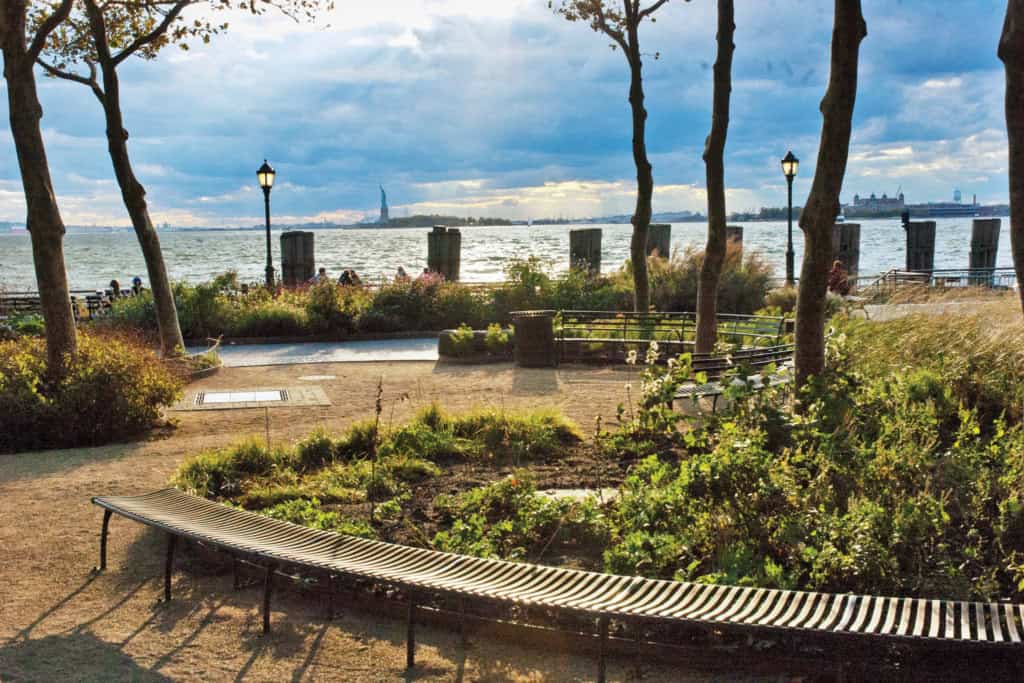
- On your left will be Battery Park. In the distance inside the park, you can see Castle Clinton. This was the first processing center of the immigrants that arrived from the 1600’s to 1892 (before Ellis Island opened)
- There is also a public restroom if you walk a few feet into the park if needed.
#12. Keep walking North on State Street until you see the Charging bull at the top of Bowling Green
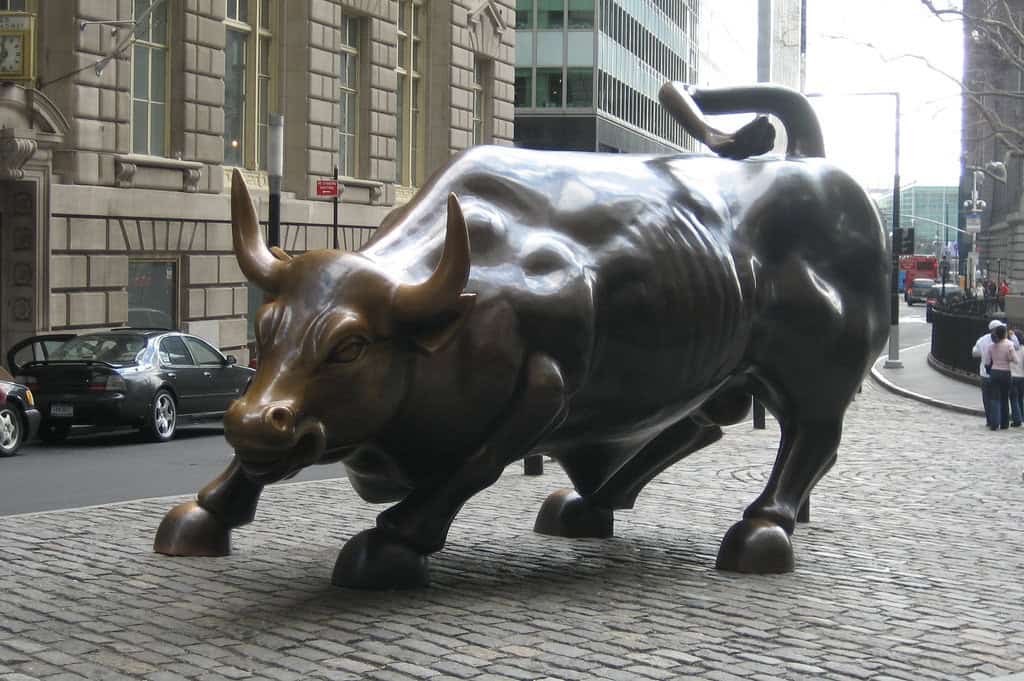
- This 7100-pound bronze bull was gifted to the city by designer Arturo Dimodica.
- The bull symbolizes the strength and resilience that the city and the stock market had, after the 1987 stock market crash.
- The artist originally placed the bull in the middle of the night on December 15th, 1989 in front of the NYSE, but it was quickly removed by police as it was blocking traffic. It wasn’t until three months later that the city approved this new location for the bull.
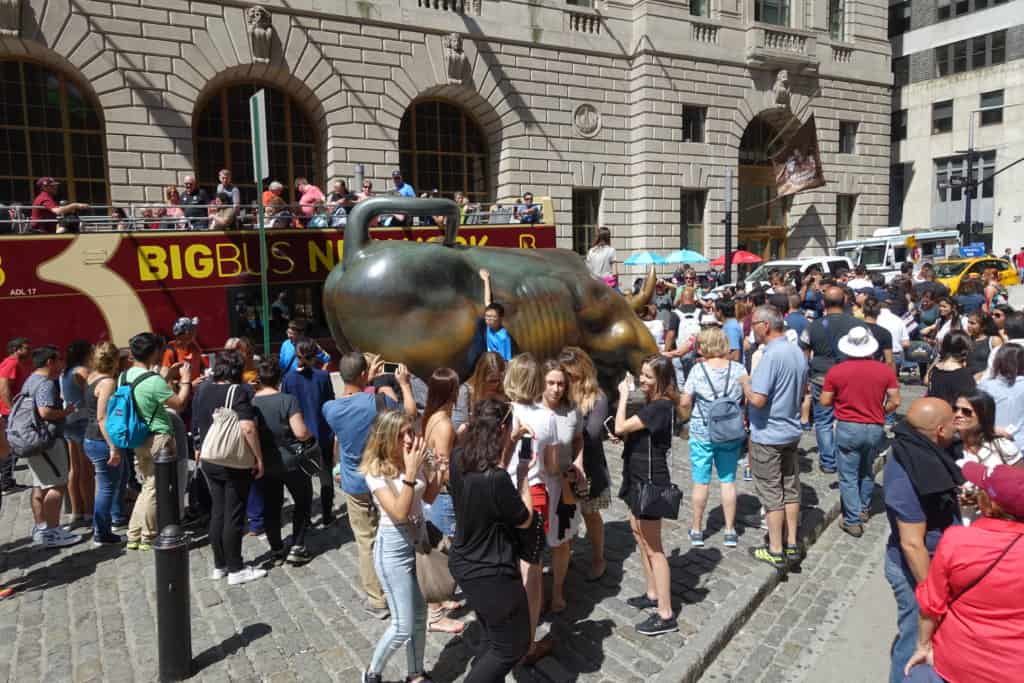
- It is said that if you rub the nose and the private parts of the bull, you will have good luck! Have fun trying to get that close to the bull as it is usually mobbed by people.
#13. Walk North on the East side of Broadway
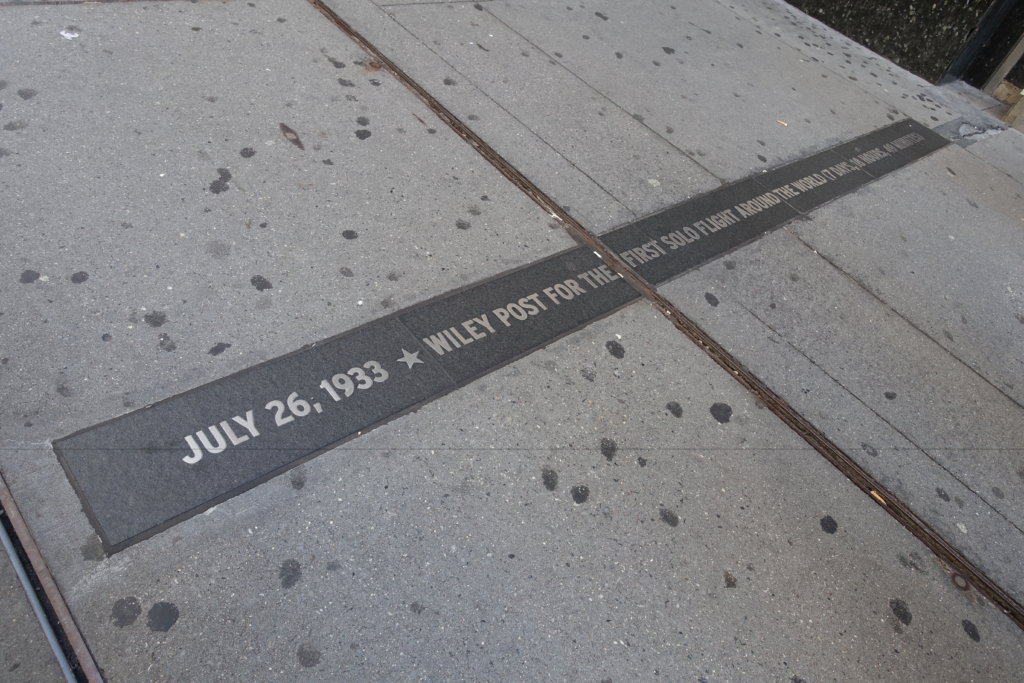
- On your way to the final stop of this downtown tour, look down at the ground while you are walking and you will see the grey Ticker Tape Parade plaques.
- The words on the ground indicate a parade that we hosted, for either a certain historical accomplishment or a leader of another country that was visiting. Years ago, people who lived and worked in the buildings above would cut up newspaper and ticker tape and throw it from their windows and balconies during the parade to celebrate. Hence the name, ticker tape parade.
#14. Continue walking North until you reach Trinity Church, located on the corner of Wall Street and Rector Street, towards the last stop of the Financial District tour
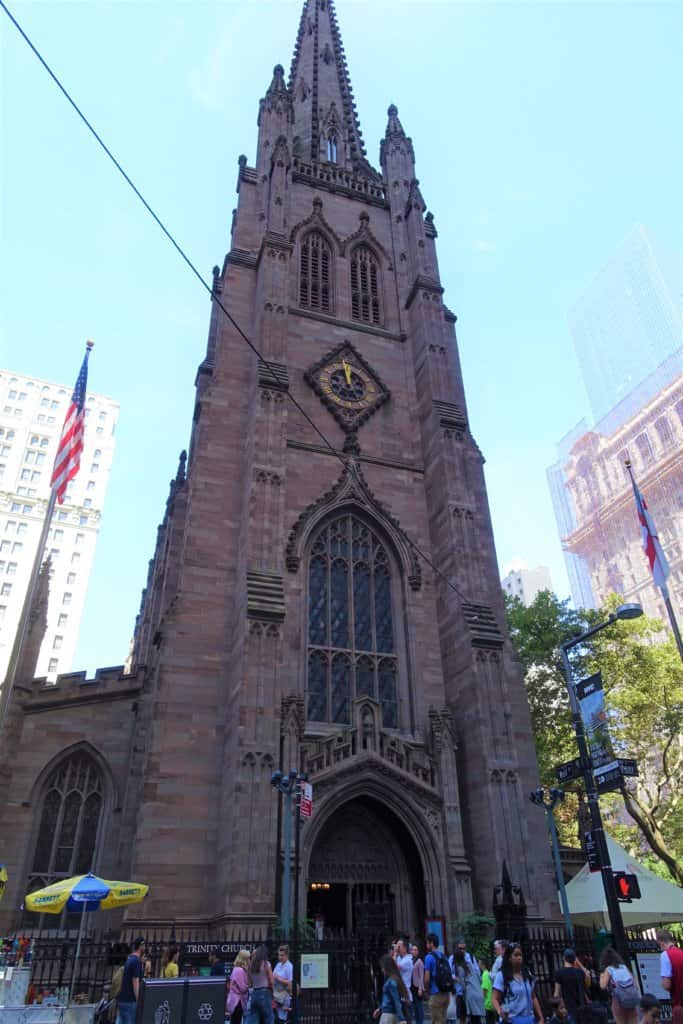
- This building is the 3rd installment of Trinity church. The first church was built in 1697 and it burned down; the second in 1788 and a blizzard destroyed it; and this is the third (and hopefully final) version of the church. Built in 1846, this structure withstood the debris falling from the 911 attacks, as well as Hurricane Sandy, and is still standing.
- The original rent for the land in the 1600’s when the original Dutch settlers arrived was 60 bushels of wheat a year.
- In the 1800’s, we asked the British if we could use the land to rebuild our sacred Trinity Church and they agreed. The rent to use the land would now be one peppercorn a year.
- In 1976 Queen Elizabeth came to visit Trinity Church, and the deacon at the time handed her a bag of 279 peppercorns. One peppercorn for every year we owed them for renting the land!
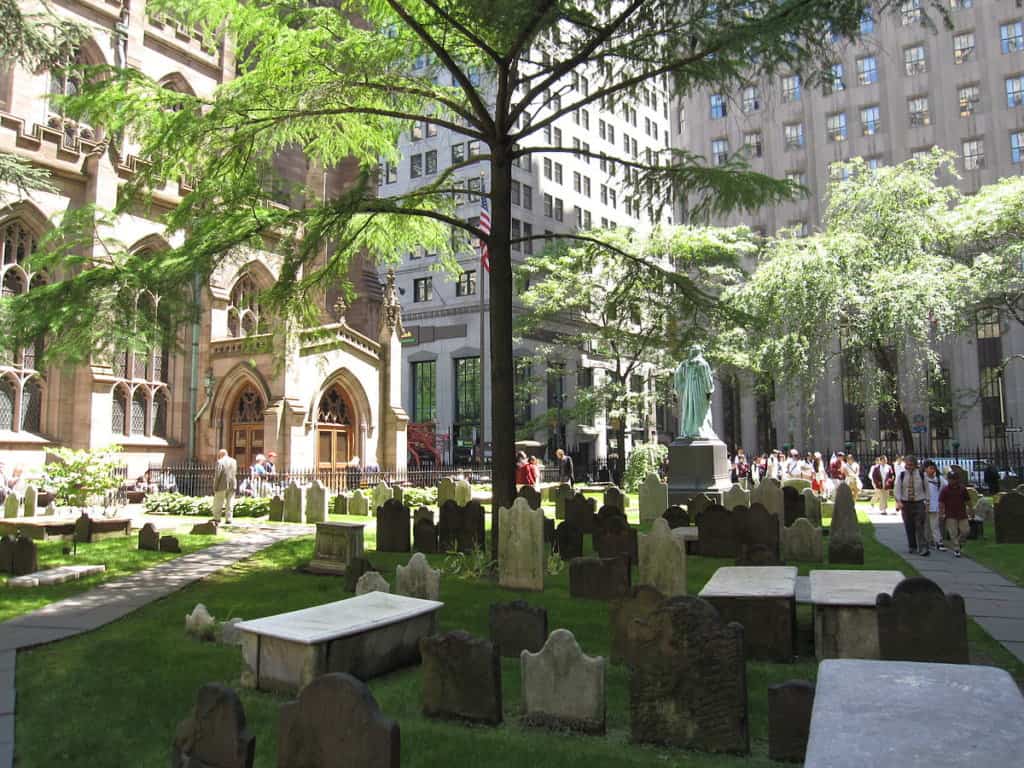
Last stop on the Financial District Tour
- Alexander Hamilton is buried in the Trinity Church Cemetery.
- He was most famous for his role in helping to rebuild NYC after the American Revolution and was one of the founding fathers of the United States of America.
- Alexander and Hamilton and Aaron Burr, the Vice President at the time, did not like each other and decided to settle their agreements in a dual in 1804.
- The dual occurred in New Jersey and back then a dual was said to be settled if both men showed up and fired their weapons into the air. The courage that they displayed by just showing up, was enough to settle a dual. Only one small problem that day, Burr did not shoot into the air. He shot Hamilton in the stomach, killing him. You can read all the dual details HERE.
- You can see the actual pistols used that day on display in the JP Morgan Headquarters on Park Ave.
You did it! You just saw the Financial District in under an hour!
We hope you enjoyed this self-guided walking tour of the Financial District. If you need to get off your feet for a bit after the tour and are hungry, jump in a cab or take the 6 train north to Astor Place and enjoy a beer and a bite to eat at the Oldest Irish Bar in NYC, McSorley’s, located at 15 East 7th street in the East Village.
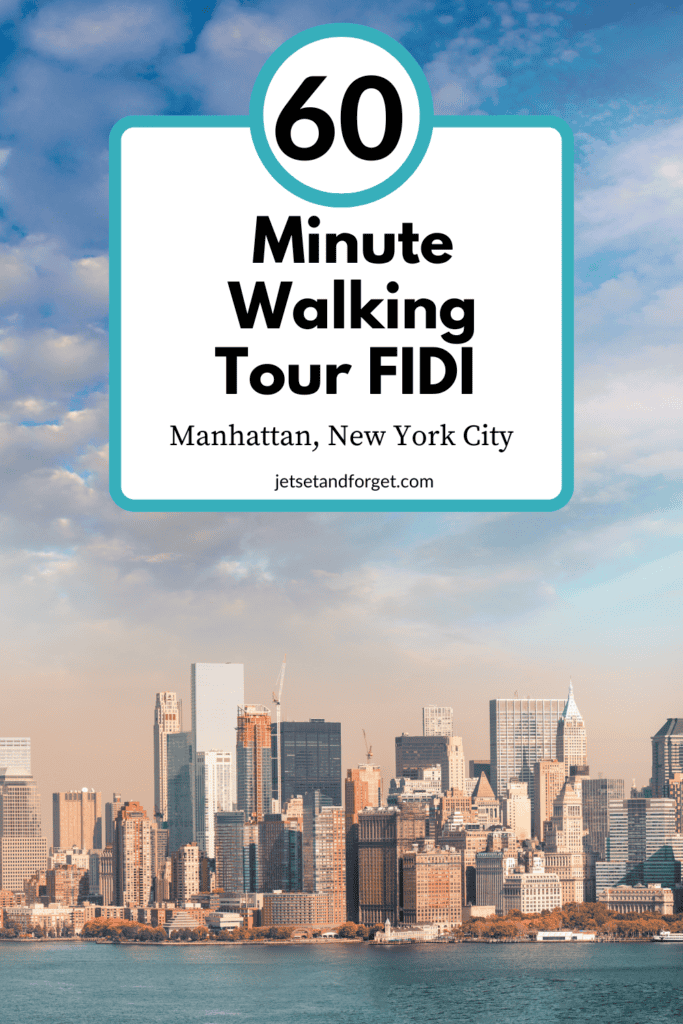
Really informative and helpful. I liked the way you have written the article. Thank you for sharing this. 🙂
Thanks Ratheesh. We took a while on this one as NYC is our home base and we really love writing about it. Glad you enjoyed it!
“Thank you for the updates! Planning for a solo visit to New york next year.
Hence your updates are very useful in planning! Thanks again!”
You will have an amazing time, NYC is safe and so much to do. Enjoy!